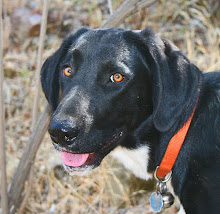Adventures in camera trapping and zoology, with frequent flashbacks and blarney of questionable relevance.
About Me

- Camera Trap Codger
- Native Californian, biologist, wildlife conservation consultant, retired Smithsonian scientist, father of two daughters, grandfather of four. INTJ. Believes nature is infinitely more interesting than shopping malls. Born 100 years too late.
Sunday, November 6, 2011
When the water's low
It didn't take long for the great blue heron to nail something in the darkness -- perhaps a tadpole or fish.
With the exception of weasels and ringtails, it seems almost everything at the Chimineas Ranch gravitates to the waterholes in late summer.
They don't always just stop for a drink either. This pool was filled with fish, perhaps bluegills, and the raccoons waded about while the pigs rooted on the banks.
For the life of me I can't identify the prey.
Can you?
Subscribe to:
Post Comments (Atom)



10 comments:
It looks like it could be a crayfish maybe? I have seen grey heron take these
A couple of years ago, while I was watching the kids on the soccer field (I am a playground monitor at a grade school) a Great Blue Heron flew down to the far end. It began to walk slowly around, clearly hunting. It froze then struck it's beak into a gopher hole, and pulled out a wriggling gopher which it tossed down it's throat, whole and still wiggling. The kids were shrieking "save it, Mrs. Sorensen!" , but all I could say is, "everything has to eat and the heron just had lunch". This elicited the "eeeuuu" response so I retorted "where do you think hamburgers come from!". That shut them up!
Britta
Maybe some vegetation came along for the ride and the prey item is much smaller and out of sight. The cat-tails (tules?) get really dark when rotting below the water surface.
crayfish is exactly what I was going to say, and I just read that they are (allegedly, mind you =) ) not native to San Luis Obispo Creek, but were introduced. So, they are apparently in SLO. Anyhow, that's what it looks like to me. GBHs are amazing predators. Apparently they'll also kill and eat a rattlesnake!
My guess is that it's some kind of catfish. Introduced no doubt. I follow another blog that has photos of a GBH catching mice in a field.
Nice photos Chris! I would also agree the object in the Great Blue Heron's bill has a definite Crayfish silohuette.
I didn't realize that GBHs fished at night....
Thanks folks, Random Truth says there were a lot of little catfish in that pool.
Hello!
I'm from Carajas - Brazil.
I also work in a (Carajás National Forest - PA) eat Trap.
Federal Rural University of Amzônia - UFRA.
I love the blog and work from you!
Sensational!
Descup by bad English!
Hugs!
Glad you like the blog, Filho, and thank you for the comment. I hope you are camera trapping down there in Brazil.
Post a Comment